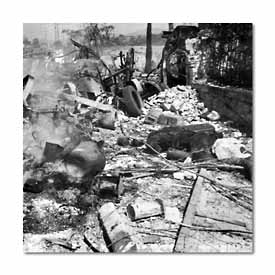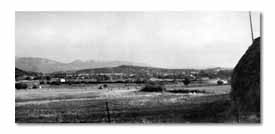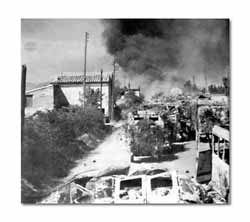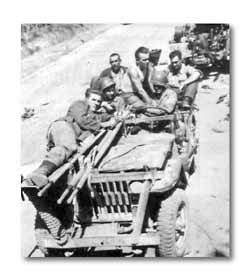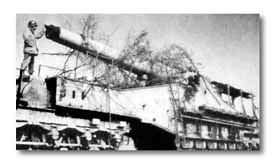M0NTELIMAR
From the hills lining the Rhone Valley north of Montelimar, reconnaissance units of the Butler Task Force watched enemy traffic stream up the main valley road, and blocked enemy armor trying to get there through Puy-St. Martin. Battle was joined on August 23 as a battalion of the 141st Infantry, advancing on Montelimar from the north, was stopped one kilometer short of the town, small-scale counterattacks developing along its flank. By midnight enemy infiltration threatened its supply lines and the battalion was forced to withdraw. With increasing fury, as more and more troops were penned in a smaller and smaller area, the Nineteenth Army dashed itself against the thin, tenuous 36th Division line, the only bar across its escape route to the north. Enemy activity was reported around the entire perimeter of the Division sector. In the early phase both sides alternately sparred for the showdown. More Division troops hastily arrived on the scene and were disposed along a broad front to hem in and cut off the German lifeline. The 142nd rushed over from Gap and Guillestre to defensive positions near Nyons. The 143rd hurried down from Grenoble. It was the 24th before the entire Division was in the area.
General Dahlquist elected to defend along the little Rubion streambed (in front of a vital supply road) on a flat bowl-shaped plain backed up by a wall of hills. Division artillery went into the hills, from there began to fire missions in a great are south, west and north. At the Rhone side of the line Division troops were committed to putting a final seal on the main valley highway. P-47’s swooped in, pounded and destroyed all bridges across the Rhone, forcing the enemy to remain on the east bank. The Germans in the pocket massed about three divisions strong, determined to preserve their escape route. The crack I 11th Panzer Division was one of them. On two successive days regiments of the German 198th Division bolted against the center of the Rubion line at Bonlieu and were thrown back in a fury of fighting by battalions of the 143rd and 142nd.
Heavy fighting raged until the 30th. Further efforts to seize La Coucourde and to recapture and block Route Seven were not completely successful though much damage was inflicted on the enemy. The 3rd Battalion 143rd, held the vital Magranon Ridge near La Coucourde, overlooking Route Seven, during three days of critical fighting. Cut off and isolated into small groups at one time, the battalion fought on to decisively defeat the German forces. This action won it the Presidential Citation.
AN ALLIED VICTORY It was the artillery at Montelimar that counted most and swayed the tide of battle. During the eight days Division field artillery battalions 131st, 132nd, 133rd, 155th-fired well over 37,000 rounds at the confined, retreating army. Supporting fires from attached battalions--141st, 977th, 93rd Armored-brought the total number of rounds expended to considerably more than 75,000. The German losses were prodigious. Key terrain held by the infantry allowed gun positions to be disposed in such a manner that the route of German withdrawal along the Rhone was under fire for sixteen miles. Long convoys were destroyed, and the entire zone was literally covered with a mass of burned vehicles, trains, equipment, dead men and dead animals. Hostile attacks, initiated simultaneously from three directions, were hammered and repulsed by the same paralyzing barrages. Physical road blocks of exploding ammunition trucks and flaming transport occurred so often that long lines of German vehicles were forced to stop, enabling the artillery and air corps to inflict great damage upon them. THE BITTER END
At Montelimar the German Nineteenth Army was virtually destroyed. As a result the enemy was unable to draw a defensive line until our forces had crossed the Moselle River.
|

